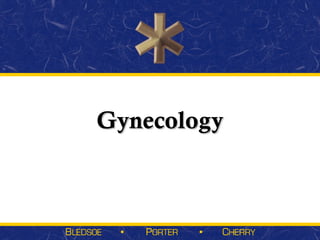
Gynecology
- 1. Gynecology
- 3. The Menstrual Cycle Monthly hormonal cycle, usually 28 days. Prepares the uterus to receive a fertilized egg. The onset of menses, known as menarche, usually occurs between the ages of 10 and 14.
- 4. Phases of the Menstrual Cycle The Proliferative Phase The Secretory Phase The Ischemic Phase The Menstrual Phase
- 5. Proliferative Phase This is the first two weeks of the menstrual cycle. Estrogen causes the uterine lining to thicken and become engorged with blood. Secretion of LH day 14 ovulation takes place. If the egg is not fertilized, menstruation takes place. If the egg is fertilized, the corpus luteum produces progesterone until the placenta takes over. Cilia sweep the egg toward the uterus. A fertilized egg normally implants in the lining of the uterus. If the egg is not fertilized, it is expelled from the uterine cavity.
- 6. Secretory Phase The secretory phase is referred to as ovulation. Progesterone increases and estrogen drops if the egg is not fertilized. The uterine becomes more vascular in preparation for implantation of a fertilized egg.
- 7. The Ischemic Phase Estrogen and progesterone levels fall without fertilization. The endometrium breaks down.
- 8. The Menstrual Phase The Menstrual Cycle Premenstrual Syndrome Menopause
- 9. Assessment of the Gynecological Patient
- 10. History Initial Assessment—SAMPLE. Does the patient complain of pain? Use OPQRST. Dysmenorrhea/dyspareunia Associated signs or symptoms. Has she ever been pregnant? Gravida/parity/abortion Document last menstrual cycle. Medications—Contraceptives.
- 11. Physical Exam Respect patient’s privacy. Be professional. Explain procedures. Observe patient. Check vital signs. Assess bleeding or discharge: Do not perform an internal vaginal exam in the field. Abdominal examination.
- 12. Management of Gynecological Emergencies General management of gynecological emergencies is focused on supportive care. Do not pack dressings in the vagina.
- 13. Specific Gynecological Emergencies Medical and Trauma
- 14. Medical Gynecological Emergencies Gynecological Abdominal Pain Pelvic Inflammatory Disease Ruptured Ovarian Cyst Cystitis Mittelschmerz Endometritis Ectopic Pregnancy
- 15. Management of Gynecological Abdominal Pain Make the patient comfortable and transport.
- 16. Vaginal Bleeding Nontraumatic Menorrhagia Spontaneous abortion
- 17. Treatment for Vaginal Bleeding Do not pack vagina. Transport Initiate oxygen and IV access based on patient condition.
- 18. Traumatic Gynecological Emergencies Causes of Gynecological Trauma Blunt trauma. Sexual assault. Blunt force to lower abdomen. Foreign bodies inserted in vagina. Abortion attempts.
- 19. Management of Gynecological Trauma Apply direct pressure over laceration. Apply cold pack to hematoma. Establish IV if patient is severe. Transport.
- 20. Sexual Assault Do not ask specific details of a sexual assault. Do not examine the external genitalia of a sexual assault victim unless there is a life-threatening hemorrhage.
- 21. Management Protect the scene. Handle clothing as little as possible. If removing clothing, bag each item separately. Do not cut through any tears or holes in clothing. Place bloody articles in brown paper bags. Do not exam the perineal area. Do not allow patient to change clothes, bathe, or douche. Do not allow patient to comb hair, brush teeth, or clean fingernails. Do not clean wounds, if possible.
- 22. Documentation State patient remarks accurately. Objectively state your observations of patient’s physical condition, environment, or torn clothing. Document evidence turned over to hospital staff. Do NOT include your opinions as to whether rape occurred.
Hinweis der Redaktion
- Vagina Female organ of copulation. Birth canal. Outlet for menstruation. Uterus Site of fetal development. Fallopian Tubes Transports the egg from the ovary to the uterus. Fertilization usually occurs here.(test question) Ovaries Primary female gonads.
- Release of the egg from the ovary is called ovulation (test question)
- Menstral phase, endometrium is shed discharge of bllod, mucus, cellular debris PMS related to changing hormones – s/s bloating, fatigue, migranes Menopause – cessation of estrogen, s/s hot flashes, night sweats, mood swings
- Most common complaints of women during child bearing years is abd pain and vaginal bleeding
- First Question, when was your last period? Dysmenorrhea – painful menstruation Dyspareunia – painful intercourse s/s – GI s/s nausea vomiting diarrhea any vaginal bleeding or discharge Gravida – number of pregnancies - para – number of deliveries – ab – preg ends before 20 weeks Document surgeries, ectopics, csections, infections, sexual activity with bleeding or pain Contraceptives, IUDs can cause perferation of uterus or infection
- Observe patient – LOC and skin color are good indicators of status Assess bleeding – 2 pads per hour significant blood loss
- O2 IV Monitor, place in trendelenburg for shock, or left lat rec with knees bent.
- PID – infection of reproductive organs. most common pain, especially 15-24 yo, mult sex partners, gonorrhea chlamydia, c/o mod to severe diffuse lower abd pain. (test question) adb pain when walking, to reduce this pts walk with a shuffling gait. Also c/o fever, chills, nausea and vomiting. Cyst – fluid filled pocket which can rupture, c/o unilateral abd pain rad to back, dyspareunia, irreg bleeding Cystitis – infection of urinary bladder, c/o pain above symphysis pubis, urinary frequency and dysuria, hematuria, low grade fever, can progress to kidneys Mittelschmerz – abd pain during ovulation Endometritis – infection of uterine lining, complication of miscarriag, D&C Ectopic – implantation of fetus outside uterus, usually in fallopian tube, life threatening surg emerg, c/o abd pain rad shoulder, missed period
- O2 IV if indicated
- Menorrhagia – excessive menstrual flow – not usually seen in field Spont abortion – suspect if more than 60 days since LMP, assoc with abd cramping, passage of clots and tissue, very emotional event
- If passing clot save for physician if possible